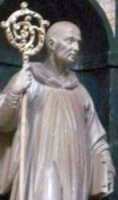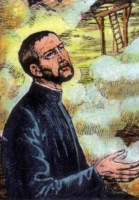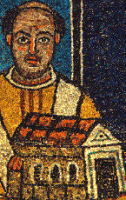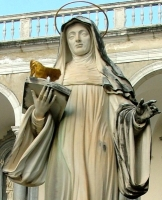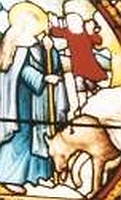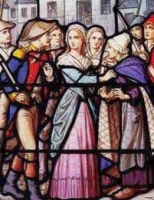St. Buonfiglio Monaldo
Feastday: February 12
He was one of seven Florentines who had joined the Confraternity of the Blessed Virgin (the Laudesi) in a particularly lax period in the city's history and who were inspired by a vision on the feast of the Assumption to take up a life of solitude and prayer. After nearly fifteen years of austerity at a hermitage on Monte Senario he took the name in 1240 of Servants of Mary, or Servites. Six were ordained, developed as mendicant friars under the direction of James of Poggibonsi and Bishop Ardingo of Florence and established many houses and foreign missions. Br. Bounfiglio served as its first prior general from 1240 to 1256 and died on Jan 1. St. John Bounagiunta succeded him, St. Bartholomew Amidei (Br. Hugh) established the order in Paris and St. Ricovero Ugoccione (Br. Sostenesw) in lGermany. SS. Benedict dell'Antella (Br. Manettus) were ordained; St. Alexis Falconieri became a lay brother and was the only one to live to see the order approved by Pope Benedict XI in 1304. The "Seven Holy Founders" of the Servites were canonized in 1887 by Pope Leo XIII. His feastday is Feb. 12.
St. John of Nicomedia
Feastday: February 12
Death: 1584
English martyrs. John Nutter was from Lancaster and was ordained at Reims in 1581 . Munden, a native of Dorset, was ordained at Reims in 1582. They were martyred at Tyburn with three priest companions. Both were beatified in 1929.
St. Febronia
Feastday: February 12
Patron: of Palagonia, Sicily
Birth: 284
Death: 304
"It must be frankly admitted that the virgin martyr St. Febronia is in all probability a purely fictious personage, but she is venerated by all the churches of the East, including that of Ethiopia, and in the West by such towns as Trani in Apulia and Patti in Sicily." "She is supposed to have suffered at Nisibis in Mesopotamia, somewhere about the year 304, in the persecution under Diocletian. No genuine records of her life and passion are available but the legend attributed to her survives in the form of an attractive romance purporting to have been written by Thomais, a nun of her convent who is said to have witnessed the events she describes."
Febronia of Nisibis, also known as Febronia of Sebapte, was a nun at Nisibis. She suffered persecution under Diocletian, who offered her freedom if she renounced her faith and married his nephew, Lysimachus, who had been leaning towards conversion to Christianity. Febronia refused and was tortured, suffered mutilation and death. Lysimachus, witnessing her suffering, converted.[2]
Febronia is one of the 140 Colonnade saints whose images adorn St. Peter's Square. She is known as a Holy Virgin Martyr.
In the Coptic Orthodox Church, her feast day is 1 Epip which corresponds to 8 July (Gregorian Calendar) or 25 June (Julian Calendar).
St. Julian the Hospitaler
புனித_ஜூலியன் (பன்னிரண்டாம் நூற்றாண்டு)
பிப்ரவரி 12
இவர் (#StJulianTheHospitaller #StJulianThePoor) பிரான்சில் இருந்த ஒரு வசதியான குடும்பத்தில் பிறந்தவர்.
ஒரு கைம்பெண் மணமுடித்து, அவரோடு மிகவும் மகிழ்ச்சியாக வாழ்ந்து வந்த இவர், தவறுதலாக இவருடைய பெற்றோரையே கொன்றுவிட, அதற்கு மன்னிப்பு வேண்டி, தன் மனைவியோடு திருத்தந்தையைப் பார்க்க உரோமைக்குச் சென்றார். திருத்தந்தையும் இவர் செய்த குற்றத்தை மன்னிக்க, இவர் மனநிறைவோடு வீட்டிற்குத் திரும்பி வந்து கொண்டிருந்தார்.
அப்பொழுது இவருக்குள், "நாம் ஏன் மக்கள் பயன்பெறும் வகையில் ஒரு மருத்துவ மனையையும் விடுதியையும் தொடங்கக் கூடாது?" என்ற எண்ணமானது தோன்றி மறைந்தது. உடனே இவர் தன்னிடமிருந்த பணத்தைக் கொண்டு மருத்துவமனையையும் விடுதியையும் தொடங்கினார்.
இதனால் அவ்வழியாகக் கடந்துபோன நோயாளர்கள், பயணிகள் யாவரும் பயன்பெற்றனர். ஒருமுறை இவருடைய விடுதியும் மருத்துவமனையும் நிரம்பி வழிந்தபோது, தொழுநோயாளர் ஒருவர் இவரிடம் வந்து, "தங்க இடம் கிடைக்குமா?" என்று கேட்டார். இவர் அதற்கு மறுப்பேதும் சொல்லாமல், தன்னுடைய படுக்கையில் அவரைத் தூங்கச் சொன்னார். அதன் பிறகுதான் தெரிந்தது, வந்திருந்தது வானதூதர் என்று.
அன்றிரவு இயேசு இவருக்குக் கனவில் தோன்றி, "ஜூலியன்! நீ உன் தவற்றிற்குப் பரிகாரமாகச் செய்யும் எல்லா நற்செயல்களையும் கண்டு மகிழ்கிறேன்" என்று சொல்லிவிட்டு மறைந்தார்.
இதன் பிறகு இவர் இறக்கின்ற வரையில், தான் செய்த நற்செயல்களைத் தொடர்ந்து செய்து வந்தார்.
Feastday: February 12
Patron: of Boatmen, carnival workers, childless people, circus workers, clowns, ferrymen, fiddlers, fiddle players, hospitallers, hotel-keepers, hunters, innkeepers, jugglers, knights, murderers, pilgrims, shepherds, to obtain lodging while traveling, travelers
Patron saint of boatmen, innkeepers, and travelers, also called "the Poor." Reported in the doubtful Golden Legend, Julian slew his noble parents in a case of mistaken identity. He believed his wife was with another man and struck them both. His wife returned home from church soon after. In penance, Julian and his wife went to Rome. Returning after receiving absolution, Julian built an inn and a hospital for the poor. He even put a leper into his own bed. That leper was an angel.
Julian the Hospitaller is a Roman Catholic saint.
History
The earliest known reference to Julian dates to the late twelfth century.[1]
There are three main theories of his origin:
Born in Le Mans, France, possibly from confusion with Saint Julian of Le Mans
Born in Ath, Belgium, around 7 AD
Born in Naples, Italy
The location of the hospitals built by him is also debated between the banks of the River Gardon in Provence and an island near the River Potenza heading to Macerata.
He was known as the patron of the cities of Ghent and Macerata. The Paternoster (Our Father prayer) of St. Julian can be found as early as 1353 in Boccaccio's Decameron, and is still passed on by word of mouth throughout some places in Italy. The account is included the 13th-century Leggenda Aurea of Genoan Giacomo da Varazze, a Dominican priest. Beautiful stained glass depicting St. Julian by an unknown artist in the Cathedral of Chartres also dates back to the 13th century. Early fresco paintings of him are found in the Cathedral of Trento (14th century) and the Palazzo Comunale di Assisi.
Golden Legend
According to Giacomo, on the night Julian was born, his father, a man of noble blood, saw pagan witches secretly lay a curse on the boy that would make him kill both his parents. His father wanted to get rid of the child, but his mother did not let him do so. As the boy grew into a handsome young man, his mother would often burst into tears because of the sin her son was destined to commit. When he finally found out the reason for her tears, he swore he "would never commit such a sin" and "with great belief in Christ went off full of courage" as far away from his parents as he could.[2]
Some versions say that it was his mother who told him at the age of 10, while others say it was a stag he met in the forest while hunting (a situation used in depicting St. Julian in statues and pictures). After fifty days of walking he finally reached Galicia, where he married a "good woman", said to be a wealthy widow.
Twenty years later, his parents decided to go look for their now thirty-year-old son. When they arrived, they visited the altar of St. James. On leaving the church they met a woman sitting on a chair outside, whom they asked for shelter for the night as they were tired. She took them in and told them that her husband, Julian, was out hunting. (This is why he is also known as the patron of hunters.) The mother and father were overjoyed to have found their son, as was Julian's wife. She treated them well and gave them her and Julian's bed. But the devil went off seeking Julian and told him that his wife was with another man.[2]
Julian returned home and found two people asleep in his bed. Thinking it they were his wife and her lover, her killed them both. When he discovered his mistake, he vowed to spend the rest of his life in charitable works. He and his wife made a pilgrimage to Rome.[2] They continued their travels until they came to a river crossing. There they built a hospice to welcome weary and sick travelers, and Julian assisted people in crossing the river.[3]
De Verazze continues: "The enemy conspired again to ruin Julian—disguised as a weak pilgrim, he was let in by Julian with the others. At midnight he woke up and made a mess of the house." The following morning Julian saw the damage and swore never to let in anyone else in his home. He was so furious he had everyone leave. "And Jesus went to him, again as a pilgrim, seeking rest. He asked humbly, in the name of God, for shelter. But Julian answered with contempt: 'I shall not let you in. Go away, for the other night I had my home so vandalized that I shall never let you in.' And Christ told him 'Hold my walking-stick, please.' Julian, embarrassed, went to take the stick, and it stuck to his hands. And Julian recognized him at once and said 'He tricked me, the enemy who does not want me to be your faithful servant. He knelt and Jesus forgave him, and Julian asked, full of repentance, forgiveness for his wife and parents.
Veneration in Malta
Devotion to St. Julian started in the Maltese Islands in the 15th century after the discovery of his relics in the city of Macerata. It was introduced by the noble family of De Astis, high-ranking in Malta at the time, who had strong connections with the Bishop of Macerata. Three churches were built in his honor before the arrival of the Knights: in Tabija, towards Mdina; in Luqa; and in Senglea (Isla). This last one had a storage room for hunters, and served to popularize this devotion through the sailors arriving at the Three Cities. In the 16th century there existed a hospital, Ospedale di San Giuliano, in the Citadel in Gozo, showing a wide devotion to the saint. Being an order of hospitaliers, the Knights of St. John helped widen further this devotion. In 1539 they rebuilt the church in Senglea and in 1590 built another church in the parish of Birkirkara, a section that since then was called St. Julian's. In 1891 the church was made a parish, the only one ever dedicated to the saint in Malta.
Patronage
St. Julian was invoked as the patron of hospitality by travelers on a journey and far from home pray hoping to find safe lodging.
St. Juventius of Pavia
Feastday: February 12
Death: 1st century
Bishop of Pavia, Italy, sent by St. Hermagoras with St. Syrus to evangelize the region. Juventius has two feast days, one alone and one with St. Syrus.
Saint Iuventius (or Iuvence) was a bishop of Pavia during the 1st century. Together with Syrus of Pavia he was sent there by Saint Hermagoras. Both Iuventius and Syrus are reported to have been the first bishop of Pavia.
Iuventius has two feast days, 8 February alone and 12 September together with Syrus.
Saint Benedict of Aniane
Also known as
• Euticius
• Witiza
• the Second Benedict
Profile
Born a Visigoth, the son of Aigul, Count of Maguelone. Educated at the court of Pepin. Courtier and cup-bearer to King Pepin and Blessed Charlemagne. Part of the 773 campaign of Charlemagne. Narrowly escaped drowning in the Tesin near Pavia, Italy while trying to save his brother.
Benedictine monk at Saint Sequanus monastery where he took the name Benedict. Lived two and one half years on bread and water, sleeping on the bare ground, praying through the night, and going barefoot.
In the Frankish empire, monasticism suffered lay ownership and the attacks of the Vikings. Monastic discipline decayed. In 779 Benedict founded the Aniane monastery on his own land; the monks did manual labor, copied manuscripts, lived on bread and water except on Sundays and great feast days when they added wine or milk, if they received any in alms. The results of his austere rule were disappointing, so he adopted the Benedictine Rule, and the monastery grew. He then reformed and inaugurated other houses; Saint Ardo travelled with him and served as his secretary.
Bishop Felix of Urgel proposed that Christ was not the natural, but only the adoptive son of God (Adoptionism); Benedict opposed this heresy, wrote against it, and assisted in the Synod of Frankfurt in 794.
Emperor Louis the Pious built the abbey of Maurmunster as a model abbey for Benedict in Alsace, France, and then Cornelimunster near Aachen, Germany, then made Benedict director of all the monasteries in the empire. The monk instituted widespread reforms, though because of opposition they were not as drastic as he had wanted.
Participated in the synods in Aachen. Benedict was an advisor and supported of the emperor. Wrote the Capitulare monasticum, a systematization of the Benedictine Rule as the rule for all monks in the empire. Compiled the Codex regularum, a collection of all monastic regulations, and Concordia regularum, showing the resemblance of Benedict's rule to those of other monastic leaders. The rules stressed individual poverty and chastity with obedience to a properly constituted abbot, himself a monk. Benedict insisted upon the liturgical character of monastic life, including a daily Conventual Mass and additions to the Divine Office. He stressed the clerical element in monasticism which led to the development of teaching and writing as opposed to manual labor in the field. This direction lapsed some after Benedict's death, but had lasting effects on Western monasticism. Benedict is considered the restorer of Western monasticism and is often called "the second Benedict".
Born
c.747 at Languedoc, France as Witiza
Died
• 11 February 821 at Cornelimunster, Aachen, Germany of natural causes
• buried on 12 February 821
Saint Eulalia of Barcelona
Also known as
Aulaire, Aulazia, Aulazie, Auzalie, Elalia, Eulalie, Eulària, Occille, Olacie, Olaia, Olaille, Olaire, Olalla, Ollala
Profile
Sanctified virgin, the forerunner of professed nun. Martyred at age 13 or 14 in the persecutions of Diocletian. Often confused with Saint Eulalia of Merida. Several villages in Guienne and Languedoc are named for her.
Born
c.290 in Barcelona, Spain
Died
• 12 February 304 at Barcelona, Spain
• interred in the church of Santa Maria del Mar, Barcelona
• relics translated to the Barcelona cathedral on 23 November 874
Canonized
633
Saint Meletius of Antioch
Also known as
Meletios, Melezio
Profile
Born to a wealthy and prominent family. Bishop of Sebaste, Armenia (modern Sivas, Turkey) in 358 following the deposing of an Arian bishop. The Arian priests revolted, and forced Meletius into exile. Chosen bishop of Antioch, Syria after that city's Arian bishop had re-located to Constantinople. The Arians in the diocese revolted, and Meletius was exiled three times, returning in 362, 367 and 378. Supported by Saint Basil of Caesarea while in exile. In 379 he called a council at Antioch to formally install orthodox Nicene Christianity as the proper profession of the faith. Baptized and ordained Saint John Chrysostom; consecrated Saint Gregory of Nazianus as bishop of Constantinople in 381.
Born
early 4th century Melitene, Lower Armenia (modern Malatya, Turkey)
Died
• 381 at Constantinople (modern Istanbul, Turkey) of natural causes
• the funeral oration was delivered by Saint Gregory of Nyssa
• buried in Antioch beside Saint Babylas
Blessed George Haydock
Additional Memorial
• 22 November as one of the Martyrs of England, Scotland, and Wales
• 29 October as one of the Martyrs of Douai
Profile
Youngest son of Evan and Helen Haydock. Educated at the English College in Douai, France, and the English College in Rome, Italy. Ordained on 21 December 1581 at Rheims, France. He then returned to England to minister to covert Catholics during the persecutions of Queen Elizabeth I. Arrested in London, England, he served 15 months in the Tower of London for the crime of being a priest; at one point he was finally allowed to administer the Sacraments to fellow prisoners. Zealous supporter of the pope, and not secular authorities, as ruler of the Church. Martyr.
Born
c.1557 in Cottam Hall, Lancashire, England
Died
hanged, drawn and quartered on 12 February 1584 in Tyburn, London, England
Beatified
22 November 1987 by Pope John Paul II
Blessed Ludan
Also known as
Ludano, Ludain, Luden
Profile
Born to the Scottish nobility, the son of Itiboldo. Used his inheritence to build a hospital for the poor, a hospice for pilgrims. Died while returning from pilgrimage to the tombs of the Apostles.
Born
12th century Scotland
Died
• 1202 in Nordheim, Alsace, France of natural causes
• while asleep under an elm tree, Ludan received a vision that he was about to die; he prayed to receive Holy Communion one more time; an angel then appeared with the Eucharist
• bells in local churches are reported to have spontaneously rang at the moment of his death
• two local parishes each wanted Ludan to rest at their church; an abbot settled the matter by having the body put in a cart, the cart yoked to a wild horse, and the horse turned loose; the horse stopped in front of the church of Saint George, and there Ludan was buried
• relics enshrined in Saint Ludan church in Nordheim
Blessed Humbeline of Jully
துறவி ஹீம்பலீனா Humbelina OSB
பிறப்பு
11 ஆம் நூற்றாண்டு,
பிரான்சு
இறப்பு
1130,
ஜூலி-சுர்-சார்சே Jully-sur-Sarce
இவர் கிளேர்வாக்ஸ் Clairvaux நகரைச் சேர்ந்த்த புனித பெர்னார்டு Bernhard அவர்களின் சகோதரி. இவர் தன் இளம் வயதிலேயே தன் குடும்பத்தை விட்டு வெளியேறி, துறவற மடத்தில் வாழ்ந்து வந்தார். பின்னர் தன்னை முழுவதுமாக இறைவனுக்கு அர்ப்பணித்து துறவியானார். மேலும் இவரைப்பற்றிய வரலாறு, அதிகம் கொடுக்கப்படவில்லை. இவர் தனது இறுதிவரை துறவியாகவே வாழ்ந்து இறந்தார் என்று சொல்லப்படுகின்றது. இவர் புனித பெனடிக்ட் துறவற சபையில் தலைமை பொறுப்பில் ஈடுபட்டார் என்றும் கூறப்படுகின்றது. இவரது கல்லறையின் மேல் சிறிய கெபி ஒன்று கட்டப்பட்டு வணக்கம் செலுத்தப்படுகின்றது. இவர் துறவிகளின் முன்மாதிரி என்று சொல்லப்பட்டார்
Also known as
Hombeline, Homberga, Humbelina, Ombelina, Ombeline, Ombline
Additional Memorial
21 August in the Cistercian martyrology
Profile
Younger sister of Saint Bernard of Clairvaux. Married to Guy de Narcy, a member of the ruling family of Lorraine (in modern France). After a few years of rich and frivolous living, Humbeline turned her back on the worldly life; after a few more years she, with her husband's approval, became a Benedictine nun at Jully-les-Nonnains convent near Troyes, France. Served as abbess there.
Born
1092 in Dijon, France
Died
• 21 August 1136 at the Jully-les-Nonnains convent in France of natural causes
• several family members, include Saint Bernard were with her
• buried in Jully-les-Nonnains
Beatified
1703 by Pope Clement XI (cultus confirmed)
Patronage
against loss of parents
Saint Goscelinus of Turin
Also known as
• Goscelinus of San Solutore
• Goslin, Goslino, Gozzelino, Gozzelinus
Profile
Born to the Italian nobility. Benedictine monk in 1006 at the San Solutore Abbey near Turin, Italy soon after its founding. Reluctant abbot in of the house in 1031, he served the remaining 22 years of his life.
Died
• 12 February 1053 of natural causes
• relics enshrined in San Solutore Abbey in 1472
• the San Solutore Abbey was destroyed during the occupation of Italy by the French in 1536, and the relics were transferred Consolata Benedictine monastery
• relics enshrined in the church of Saints Solutore, Ottavio and Avventore in Turin, Italy on 19 January 1575
• relics transferred to the church's new constructed chapel of Saint Paul in 1584
Blessed James Fenn
Additional Memorial
• 29 October as one of the Martyrs of Douai
• 1 December as one of the Martyrs of Oxford University
Profile
Educated at Corpus Christi College and Gloucester Hall at Oxford University. Married layman and schoolmaster. Widower. He studied at Rheims, France, and was ordained in 1580. He returned to England to minister to covert Catholics in the area of Somerset. Arrested for his faith, he was convicted of treason when he remained loyal to Rome and refused to take the Oath of Supremacy. Martyr.
Born
at Montacute, Somerset, England
Died
hanged, drawn, and quartered on 12 February 1584 at Tyburn, London, England
Beatified
15 December 1929 by Pope Pius XI
Saint Anthony Kauleas
Also known as
• Anthony Cauleas
• Antony Cauleas
• Antony Kauleas
• Antony II of Constantinople
Profile
Born to a noble family from Phrygia who had moved to the country to escape persecution by the iconoclasts. Monk near Constantinople at age 12. Abbot of his house. Patriarch of Constantinople in 893. He worked to heal the schisms created by his predecessor Photius, presiding over the Fourth Æcumenical Council of Constantinople in 869 and 870 which condemned or reversed all that Photius had done; all records of the council were destroyed by later schismatics. Throughout his life Antony was known for his personal holiness, his deep personal prayer life, and the sanctity he brought to his offices.
Born
829 near Constantinople
Died
12 February 901 of natural causes
Blessed Jak Bushati
Profile
Studied at the Pontifical Seminary of Shkodrë, Albania. Ordained on 19 May 1915 as a priest of the archdiocese of Shkodrë-Pult, Albania. Imprisoned and tortured to death in the anti–Christian persecutions of the Albanian Communist government. Martyr.
Born
8 August 1890 in Shkodrë, Albania
Died
12 February 1949 in Shkodrë, Albania
Beatified
• 5 November 2016 by Pope Francis
• beatification celebrated at the Square of the Cathedral of Shën Shtjefnit, Shkodër, Albania, presided by Cardinal Angelo Amato
Saint Ethelwald of Lindisfarne
Also known as
Aethelweald, Aedilauld, Ethilwald, Ethelwold
Additional Memorial
21 April (translation of relics)
Profile
Leather worker and bookbinder. Monk. Assistant to Saint Cuthbert of Lindisfarne. Prior and abbot of Old Melrose monastery in Scotland. Bishop at Lindisfarne in 721. Commissioned the famous Lindisfarne Book of Gospels, now in the British Museum, and made its jewel-encrusted leather cover, now lost. Wrote the Hymnal of Ethelwald.
Born
at Northumbria, England
Died
• c.740
• buried in the cathedral at Lindisfarne
• relics taken to Durham in the hope they would prevent Danish invasion
Blessed John Munden
Additional Memorial
• 29 October as one of the Martyrs of Douai
• 1 December as one of the Martyrs of Oxford University
Profile
Studied at New College, Oxford. Teacher and schoolmaster. Studied for the priesthood at Rheims, France, and Rome, Italy. Ordained in 1582. Martyr.
Born
at Coltley, South Maperton, Dorset, England
Died
hanged, drawn, and quartered on 12 February 1584 at Tyburn, London, England
Beatified
15 December 1929 by Pope Pius XI
Blessed Thomas Hemeford
Additional Memorial
1 December as one of the Martyrs of Oxford University
Profile
Educated at Oxford, England. Convert to Catholicism. Seminarian at the English College in Rome, Italy; ordained in 1583. He returned to England to minister to covert Catholics during the persecutions of Queen Elizabeth I. Arrested and executed for the crime of being a priest. Martyr.
Born
Stoke, Dorset, England
Died
hanged, drawn and quartered on 12 February 1584 in Tyburn, London, England
Beatified
15 December 1929 by Pope Pius XI
Blessed Paolo of Barletta
Profile
Joined the Augustinians as a young man. Feeling a need to devote himself to God, he wanted to "go where no one knew him except God alone", and he withdrew for a while to live as a hermit in prayer and penance in the province of Portugal. Missionary to the island of San Thomé, in the East Indies.
Born
early 16th century in Barletta, Italy
Died
13 May 1580 San Thomé, East India of natural causes
Blessed Benedict Revelli
Profile
Benedictine monk of Santa Maria dei Fonti, Italy. Hermit on the island of Gallinaria in the Gulf of Genoa, Italy. Bishop of Albenga, Italy in 870.
Died
• c.900
• buried at the church of Santa Maria de Fontibus
• relics enshrined in a chapel dedicated to him there in 1409
• following a collapse of the old church in 1614, the relics were enshrined in a new wooden reliquary
Beatified
by Pope Gregory XVI (cult confirmed)
Blessed Josep Gassol Montseny
Profile
Seminarian of the archdiocese of Tarragona, Spain. Martyred in the Spanish Civil War.
Born
31 March 1915 in Solivella, Tarragona, Spain
Died
12 February 1937 in Sarral, Tarragona, Spain
Beatified
• 13 October 2013 by Pope Francis
• beatification celebrated in Tarragona, Spain
Blessed John Nutter
Additional Memorial
29 October as one of the Martyrs of Douai
Profile
Brother of Blessed Robert Nutter. Fellow at Saint John's College, Cambridge. Studied for the priesthood at the English College in Rheims, France. Ordained in 1581. Martyr.
Born
at Burnley, Lancashire, England
Died
hanged, drawn, and quartered on 12 February 1584 at Tyburn, London, England
Beatified
15 December 1929 by Pope Pius XI
Saint Sedulius
Also known as
• Seadhal, Siadal, Siadhal
• the Christian Virgil
Profile
Wrote the epic poem Carmen Paschale. He left Ireland to found a school of poetry in Athens. May have been a disciple of Saint Ailbhe. In 494, a decree of the First Roman Council contained a phrase "honoring by signal praise the Paschal Work of the Venerable man, Sedulius".
Born
Irish
Saint Alexis of Kiev
Also known as
• Alexius of Kiev
• Alexius of Moscow
Profile
Russian nobleman who gave up his worldly position to become a Basilian monk. Archbishop of Kiev. Well educated, but he was more known for his spiritual wisdom; even the Sultan of the Turks in Asia Minor sought his advice.
Died
1364
Blessed Ladislas of Hungary
Profile
Franciscan friar. Betrayed by a heretic monk, he and several of his religious brothers were martyred by order of King Bazarath.
Died
1369 at Vidin (in modern Bulgaria)
Blessed Nicholas of Hungary
Profile
Franciscan friar. Betrayed by a heretic monk, he and several of his religious brothers were martyred by order of King Bazarath.
Died
1369 at Vidin (in modern Bulgaria)
Blessed Gregory of Traguio
Profile
Franciscan friar. Betrayed by a heretic monk, he and several of his religious brothers were martyred by order of King Bazarath.
Died
1369 at Vidin (in modern Bulgaria)
Saint Modestus the Deacon
Profile
Deacon. Martyred in the persecutions of Diocletian.
Born
Sardinia (part of modern Italy)
Died
• c.304
• relics moved to Benevento, Italy c.785
Blessed Anthony of Saxony
Profile
Franciscan friar. Betrayed by a heretic monk, he and several of his religious brothers were martyred by order of King Bazarath.
Died
1369 at Vidin (in modern Bulgaria)
Blessed Thomas of Foligno
Profile
Franciscan friar. Betrayed by a heretic monk, he and several of his religious brothers were martyred by order of King Bazarath.
Died
1369 at Vidin (in modern Bulgaria)
Saint Damian of Africa
Profile
Soldier. Martyr.
Died
in Africa, date unknown
Saint Damian of Rome
Profile
Martyr.
Died
• in Rome, Italy, date unknown
• relics discovered in the catacombs of Saint Callistus, and sent to Spain
Saint Gaudentius of Verona
Profile
Bishop of Verona, Italy.
Died
• c.465
• relics in the basilica of Saint Stephen, Verona, Italy
Saint Julian of Alexandria
Profile
Martyr.
Died
160 at Alexandria, Egypt
Saint Modestus of Carthage
Profile
Martyr.
Died
c.160 at Carthage
Patronage
Cartagena, Spain
Saint Ammonius of Alexandria
Profile
Child martyr.
Saint Modestus of Alexandria
Profile
Child martyr.
Martyrs of Albitina
Profile
During the persecutions of Diocletian, troops were sent to the churches of Abitina, North Africa on a Sunday morning; they rounded up everyone who had arrived for Mass, and took them all to Carthage for interrogation by pro-consul Anulinus. The 46 who proclaimed their Christianity were executed. We know some of their names and stories
• Ampelius
• Cassiano
• Ceciliano
• Cecilia
• Danzio
• Deciano
• Emeritus
• Ercolina
• Eva
• Fausto
• Felice (2 by this name)
• Felix
• Gennara (2 by this name)
• Gennaro
• Giriale
• Hilarion
• Maggiore
• Margherita
• Martino
• Mary
• Massimiano
• Matrona (2 by this name)
• Onorata
• Pelusio
• Pomponia
• Prima
• Quinto
• Regiola
• Restituta
• Rogatian (3 by this name)
• Rogato (2 by this name)
• Saturninus the Elder
• Saturninus the Younger
• Seconda (2 by this name)
• Thelica
• Victoria
• Vincenzo
• Vittoriano
• Vittorino
Died
tortured to death in 304 in prison at Albitina, North Africa
புனிதர் அபொல்லோனியா
(St. Apollonia)
கன்னியர்/ மறை சாட்சி:
(Virgin & Martyr)
பிறப்பு: இரண்டாம் நூற்றாண்டு
இறப்பு: கி.பி. 249
அலெக்சாண்ட்ரியா, எகிப்து
(Alexandria, Egypt)
ஏற்கும் சமயம்:
ரோமன் கத்தோலிக்க திருச்சபை
(Roman Catholic Church)
காப்டிக் மரபுவழி திருச்சபை
(Coptic Orthodox Church)
கிழக்கு மரபுவழி திருச்சபை
(Eastern Orthodox Churches)
ஓரியண்டல் மரபுவழி திருச்சபை
(Oriental Orthodox Churches)
பாதுகாவல்:
பல் மருத்துவர்கள் (Dentists)
பல் சம்பந்தமான பிரச்சினைகள் (Tooth problems)
அச்டேர்போஸ், பெல்ஜியம் (Achterbos, Belgium)
அரிக்கியா, இத்தாலி (Ariccia, Italy)
குக்காரோ மோன்ஃபெர்ரடோ, இத்தாலி (Cuccaro Monferrato, Italy)
நினைவுத் திருநாள்: ஃபெப்ரவரி 12
புனிதர் அபொல்லோனியா, அலெக்சாண்ட்ரியா (Alexandria) நாட்டில், “ரோமானிய பேரரசின் பேரரசர்” (Emperor of the Roman Empire) “டேசியஸ்” (Gaius Messius Quintus Trajanus Decius) என்பவருடைய ஆட்சிகாலத்தில், கிறிஸ்தவர்களுக்கெதிரான கலகத்தின்போது, உள்ளூர் கிளர்ச்சியாளர்களால் துன்புறுத்தப்பட்ட கிறிஸ்தவ கன்னியர்களில் ஒருவர் ஆவார். புராணங்களின்படி, துன்புறுத்தலின்போது அவருடைய பற்கள் வலுக்கட்டாயமாக பிடுங்கப்பட்டன. இதன்காரணமாக பல் மருத்துவம், பல் நோய்களால் துன்புறுவோர் மற்றும் இன்னபிற பல் பிரச்சினைகளால் துன்புறுவோருக்கு இவர் பாதுகாவலராவார்.
கிறிஸ்தவ வரலாற்றாசிரியர்களின் கூற்றின்படி, “பேரரசன் பிலிப்” (Emperor Philip the Arab) ஆட்சியின் கடைசி ஆண்டில், ஒரு அலெக்சாண்ட்ரிய கவிஞர், அலெக்சாண்ட்ரியாவில் கிறிஸ்தவர்களுக்கெதிரான கலகங்கள் உச்சத்தை எட்டும் என்றும் நாடே இரத்தக்களரியாகும் என்றும் தீர்க்கதரிசனம் சொன்னார். அதன்படியே கிறிஸ்தவர்களுக்கெதிரான துன்புறுத்தல்கள் நிகழ்ந்தன. அதனை ஆட்சியாளர்களாலேயே அடக்க இயலாமல் போனது.
அலெக்சாண்ட்ரியாவின் ஆயர் "டயோனிஸிஸ்" (Dionysius, Bishop of Alexandria) அந்தியோக்கியாவின் ஆயர் "பாபியசுக்கு" (Fabius, Bishop of Antioch) எழுதிய கடிதமொன்றில் தமது மக்கள் எவ்வாறெல்லாம் துன்புறுத்தப்பட்டார்கள், எவ்வாறெல்லாம் அவர்களது வீடுகள் உள்ளிட்ட உடைமைகள் சூறையாடப்பட்டன என்பவற்றை விளக்கி எழுதியிருந்தார். பெண் திருத்தொண்டரான அபொல்லோனியாவை பிடித்து பெண்ணென்றும் பாராமல் அடித்து துன்புறுத்தினர். மீண்டும் மீண்டும் அடித்து அவரது பற்கள் முழுவதையும் உடைத்துப் பிடுங்கினர். அவரையும் இன்னும் பல கன்னியரையும் நகருக்கு வெளியே அமைத்திருந்த விறகுக் குவியலினருகே இழுத்துச் சென்றனர். விறகுக் குவியலுக்கு தீ மூட்டினர். அவர்கள் சொல்லும் தூஷண வார்த்தைகளை சொல்லச் சொல்லி வற்புறுத்தினர். கிறிஸ்துவுக்கு எதிராக வசை பேசவோ அல்லது அவர்களது தெய்வங்களை போற்றி பிரார்த்தனை செய்யவோ வற்புறுத்தினர். அல்லது உயிருடன் தீக்கிரையாக்குவதாக பயமுறுத்தினர். அபொல்லோனியாவின் வேண்டுதலுக்கிணங்க தமது பிடியிலிருந்து அவரை சிறிதே விடுவித்தனர். அபொல்லோனியா கண்ணிமைக்கும் நேரத்தில் கொளுந்து விட்டெரியும் தீக்குள் குதித்து உயிருடன் எரிந்து உயிர்விட்டார்.









